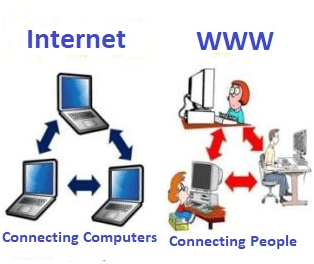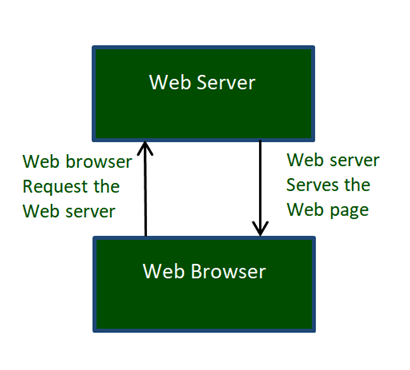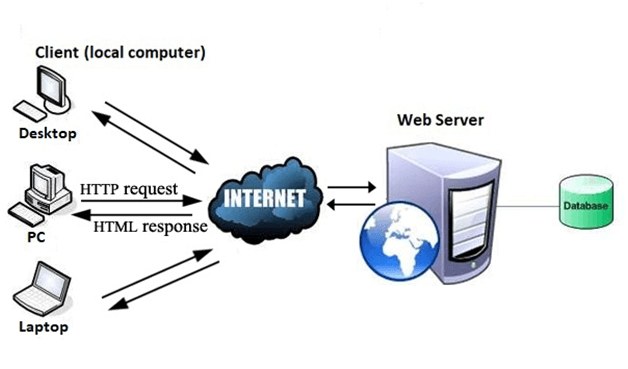What is WWW | World Wide Web – javatpoint
← prev
Mục Lục
What is World Wide Web?
World Wide Web, which is also known as a Web, is a collection of websites or web pages stored in web servers and connected to local computers through the internet. These websites contain text pages, digital images, audios, videos, etc. Users can access the content of these sites from any part of the world over the internet using their devices such as computers, laptops, cell phones, etc. The WWW, along with internet, enables the retrieval and display of text and media to your device.

The building blocks of the Web are web pages which are formatted in HTML and connected by links called “hypertext” or hyperlinks and accessed by HTTP. These links are electronic connections that link related pieces of information so that users can access the desired information quickly. Hypertext offers the advantage to select a word or phrase from text and thus to access other pages that provide additional information related to that word or phrase.
A web page is given an online address called a Uniform Resource Locator (URL). A particular collection of web pages that belong to a specific URL is called a website, e.g., www.facebook.com, www.google.com, etc. So, the World Wide Web is like a huge electronic book whose pages are stored on multiple servers across the world.
Small websites store all of their WebPages on a single server, but big websites or organizations place their WebPages on different servers in different countries so that when users of a country search their site they could get the information quickly from the nearest server.
So, the web provides a communication platform for users to retrieve and exchange information over the internet. Unlike a book, where we move from one page to another in a sequence, on World Wide Web we follow a web of hypertext links to visit a web page and from that web page to move to other web pages. You need a browser, which is installed on your computer, to access the Web.
Difference between World Wide Web and Internet:
Some people use the terms ‘internet’ and ‘World Wide Web’ interchangeably. They think they are the same thing, but it is not so. Internet is entirely different from WWW. It is a worldwide network of devices like computers, laptops, tablets, etc. It enables users to send emails to other users and chat with them online. For example, when you send an email or chatting with someone online, you are using the internet.

But, when you have opened a website like google.com for information, you are using the World Wide Web; a network of servers over the internet. You request a webpage from your computer using a browser, and the server renders that page to your browser. Your computer is called a client who runs a program (web browser), and asks the other computer (server) for the information it needs.
History of the World Wide Web:

The World Wide Web was invented by a British scientist, Tim Berners-Lee in 1989. He was working at CERN at that time. Originally, it was developed by him to fulfill the need of automated information sharing between scientists across the world, so that they could easily share the data and results of their experiments and studies with each other.
CERN, where Tim Berners worked, is a community of more than 1700 scientists from more than 100 countries. These scientists spend some time on CERN site, and rest of the time they work at their universities and national laboratories in their home countries, so there was a need for reliable communication tools so that they can exchange information.
Internet and Hypertext were available at this time, but no one thought how to use the internet to link or share one document to another. Tim focused on three main technologies that could make computers understand each other, HTML, URL, and HTTP. So, the objective behind the invention of WWW was to combine recent computer technologies, data networks, and hypertext into a user-friendly and effective global information system.
How the Invention Started:
In March 1989, Tim Berners-Lee took the initiative towards the invention of WWW and wrote the first proposal for the World Wide Web. Later, he wrote another proposal in May 1990. After a few months, in November 1990, along with Robert Cailliau, it was formalized as a management proposal. This proposal had outlined the key concepts and defined terminology related to the Web. In this document, there was a description of “hypertext project” called World Wide Web in which a web of hypertext documents could be viewed by browsers. His proposal included the three main technologies (HTML, URL, and HTTP).
In 1990, Tim Berners-Lee was able to run the first Web server and browser at CERN to demonstrate his ideas. He used a NeXT computer to develop the code for his Web server and put a note on the computer “The machine is a server. Do Not Power It DOWN!!” So that it was not switched off accidentally by someone.
In 1991, Tim created the world’s first website and Web Server. Its address was info.cern.ch, and it was running at CERN on the NeXT computer. Furthermore, the first web page address was http://info.cern.ch/hypertext/WWW/TheProject.html. This page had links to the information related to the WWW project, and also about the Web servers, hypertext description, and information for creating a Web server.
The Web Grows:
NeXT computer platform was accessible by a few users. Later, the development of ‘line-mode’ browser, which could run on any system, started. In 1991, Berners-Lee introduced his WWW software with ‘line-mode’ browser, Web server software and a library for developers.
In March 1991, it was available to colleagues who were using CERN computers. After a few months, in August 1991, he introduced the WWW software on internet newsgroups, and it generated interest in the project across the world. Graphic interface for the internet, first introduced to the public on 6 August 1991 by Tim Berners-Lee. On 23 August 1991, it was available to everyone.
Becoming Global:
The first Web server came online in December 1991 in the United States. At this time, there were only two types of browsers; the original development version which was available only on NeXT machines and the ‘line-mode’ browser which was easy to install and run on any platform but was less user-friendly and had limited power.
For further improvement, Berners-Lee asked other developers via the internet to contribute to its development. Many developers wrote browsers for the X-Window System. The first web server, outside Europe, was introduced at Standard University in the United States in 1991. In the same year, there were only ten known web servers across the world.
Later at the beginning of 1993, the National Center for Supercomputing Applications (NCSA) introduced the first version of its Mosaic browser. It ran in the X Window System environment. Later, the NCSA released versions for the PC and Macintosh environments. With the introduction of user-friendly browsers on these computers, the WWW started spreading tremendously across the world.
Eventually, the European Commission approved its first web project in the same year with CERN as one of its partners. In April 1993, CERN made the source code of WWW available on a royalty-free basis and thus made it free software. Royalty-free means one has the right to use copyright material or intellectual property without paying any royalty or license fee. Thus, CERN allowed people to use the code and web protocol for free. The technologies that were developed to make the WWW became an open source to allow people to use them for free. Eventually, people started creating websites for online businesses, to provide information and other similar purposes.
At the end of 1993, there were more than 500 web servers, and the WWW has 1% of the total internet traffic. In May 1994, the First International World Wide Web conference was held at CERN and was attended by around 400 users and developers and popularly known as the “Woodstock of the Web.” In the same year, the telecommunication companies started providing internet access, and people have access to WWW available at their homes.
In the same year, one more conference was held in the United States, which was attended by over 1000 people. It was organized by the NCSA and the newly-formed International WWW Conference Committee (IW3C2). At the end of this year (1994), the World Wide Web had around 10000 servers and 10 million users. The technology was continuously improved to fulfill growing needs and security, and e-commerce tools were decided to be added soon.
Open standards:
The main objective was to keep the Web an open standard for all rather than a proprietary system. Accordingly, CERN sent a proposal to the Commission of the European Union under the ESPRIT program “WebCore.” This project’s objective was to form an international consortium in collaboration with Massachusetts Institute of Technology (MIT), the US. In 1994, Berners-Lee left CERN and joined MIT and established the International World Wide Web Consortium (W3C) and a new European partner was needed for W3C.
The European Commission approached the French National Institute for Research in Computer Science and Controls (INRIA), to substitute the CERN’s role. Eventually, in April 1995, INRIA became the first European W3C host and in 1996 Keio University of Japan became another host in Asia.
In 2003, ERCIM (European Research Consortium in Informatics and Mathematics) replaced INRIA for the role of European W3C Host. Beihang University was announced as the fourth Host by W3C in 2013. In September 2018, there were over 400 member organizations around the world.
Since its inception, the Web has changed a lot and is still changing today. Search engines have become more advanced at reading, understanding, and processing information. They can easily find the information requested by users and can even provide other relevant information that might interest users.
How the World Wide Web Works?
Now, we have understood that WWW is a collection of websites connected to the internet so that people can search and share information. Now, let us understand how it works!

The Web works as per the internet’s basic client-server format as shown in the following image. The servers store and transfer web pages or information to user’s computers on the network when requested by the users. A web server is a software program which serves the web pages requested by web users using a browser. The computer of a user who requests documents from a server is known as a client. Browser, which is installed on the user’ computer, allows users to view the retrieved documents.

All the websites are stored in web servers. Just as someone lives on rent in a house, a website occupies a space in a server and remains stored in it. The server hosts the website whenever a user requests its WebPages, and the website owner has to pay the hosting price for the same.
The moment you open the browser and type a URL in the address bar or search something on Google, the WWW starts working. There are three main technologies involved in transferring information (web pages) from servers to clients (computers of users). These technologies include Hypertext Markup Language (HTML), Hypertext Transfer Protocol (HTTP) and Web browsers.
Hypertext Markup Language (HTML):

HTML is a standard markup language which is used for creating web pages. It describes the structure of web pages through HTML elements or tags. These tags are used to organize the pieces of content such as ‘heading,’ ‘paragraph,’ ‘table,’ ‘Image,’ and more. You don’t see HTML tags when you open a webpage as browsers don’t display the tags and use them only to render the content of a web page. In simple words, HTML is used to display text, images, and other resources through a Web browser.
Web Browser:

A web browser, which is commonly known as a browser, is a program that displays text, data, pictures, videos, animation, and more. It provides a software interface that allows you to click hyperlinked resources on the World Wide Web. When you double click the Browser icon installed on your computer to launch it, you get connected to the World Wide Web and can search Google or type a URL into the address bar.
In the beginning, browsers were used only for browsing due to their limited potential. Today, they are more advanced; along with browsing you can use them for e-mailing, transferring multimedia files, using social media sites, and participating in online discussion groups and more. Some of the commonly used browsers include Google Chrome, Mozilla Firefox, Internet Explorer, Safari, and more.
Hypertext Transfer Protocol (HTTP):
Hyper Text Transfer Protocol (HTTP) is an application layer protocol which enables WWW to work smoothly and effectively. It is based on a client-server model. The client is a web browser which communicates with the web server which hosts the website. This protocol defines how messages are formatted and transmitted and what actions the Web Server and browser should take in response to different commands. When you enter a URL in the browser, an HTTP command is sent to the Web server, and it transmits the requested Web Page.

When we open a website using a browser, a connection to the web server is opened, and the browser communicates with the server through HTTP and sends a request. HTTP is carried over TCP/IP to communicate with the server. The server processes the browser’s request and sends a response, and then the connection is closed. Thus, the browser retrieves content from the server for the user.
Next Topic
Difference between Search Engine and Portal
← prev
next →















![Toni Kroos là ai? [ sự thật về tiểu sử đầy đủ Toni Kroos ]](https://evbn.org/wp-content/uploads/New-Project-6635-1671934592.jpg)


